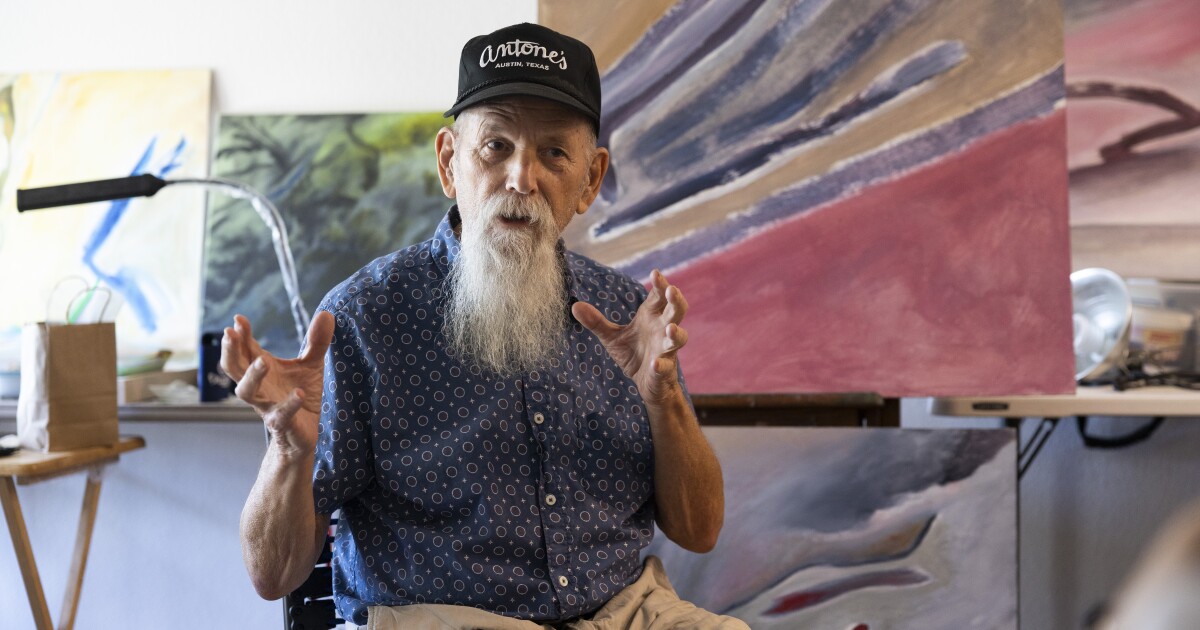A framed poster featuring an intricately drawn armadillo hangs in an apartment overlooking Lady Bird Lake. That armadillo was one of many that launched Jim Franklin to fame in Austin. He’s now the subject of a documentary premiering Friday at Austin Film Festival.
Austin filmmaker Emil Lozada led a 12-member team to produce Armadillo Man, which chronicles the 81 year old’s life. It was paid for in part with a $25,000 grant from the festival and Armadillo World Headquarters.
“I don’t know how many years he’s gonna have left,” Lozada said. “So I think being able to make a film whilst he’s still alive is important. I’m glad that we’ve been able to do that.”
Widely known for popularizing armadillos as the Austin music scene mascot, Franklin said he first encountered the animal on a hunting trip with his father when he was about 15.
Lorianne Willett
/
KUT News
One of Franklin’s armadillo paintings hangs in his apartment.
“I saw an armadillo on the other side of this pasture, slipped under the barbed wire and started creeping up on it,” he said.
The mammal then stood on its hind legs.
“I thought, ‘Oh no, it’s seen me,” Franklin continued. “So then I keep getting closer to it, and it walked between my legs — in the woods, in hunting season — and it’s a dinosaur!”
Franklin took that encounter and incorporated the animal in the poster art for Armadillo World Headquarters, a music hall he opened with Mike Tolleson and Eddie Wilson in 1970. The venue drew crowds from across the globe, and artists like Willie Nelson, Bruce Springsteen, The Velvet Underground and The Clash. It was recognized for fusing absurdity with music — a quality derived heavily from Franklin’s uninhibited nature.
Cut to 1973 when Leea Mechling first met Franklin at the venue. He was dance-roller skating in women’s pompom skates, wearing shorts with a white 1950s petticoat on his head.
“Austin would not be the place it is today without him,” Mechling said in the film. “He is actually the original person who made Austin weird.”
Mechling worked at AWHQ from 1974 until its closing in 1980. She is now the executive director of Austin’s Museum of Popular Culture, which displays Franklin’s artwork.
“What’s important, people will see [in the film], is that while he’s gotten older, his viewpoints have not aged,” she told KUT. “He really is influenced by the world around him, and it shows.”
Jim Franklin
/
Concertposterauction.com
A 1970s poster by Franklin advertises the grand opening of the Armadillo World Headquarters.
But while Franklin hasn’t changed, Austin has. Mechling said she has watched the city’s gentrification squeeze out people who defined its culture.
“We’ve got to do things differently,” she said. “Now that the damage has been done, the city and people are trying to backtrack and find ways to help that, but it’s probably too little too late.”
Despite the changes, Mechling said, once people come into contact with “the real Austin,” they want to be part of it.
“It’s alive and well,” she said. “It’s like the armadillo: It’s gone underground a bit, but it’s starting to poke its head out again.”
Lozada said he initially wanted the film to focus on the city’s gentrification, but shifted gears.
“I’ve kind of come to realize that it has been such a huge amount of time since the Armadillo World Headquarters was around,” he said. “[Austin’s] changing very quickly, but I do think that there is still a lot of the interesting parts of old Austin that are still around, if you’re looking hard enough.”
Franklin still finds slivers of the Austin he remembers, including the band Mau Mau Chaplains that performs at Flamingo Cantina on Wednesdays. He said the group often plays his favorite song, “Ram, Goat, Liver.”
“Sometimes they’ll … say, ‘Hey, Franklin’s here, so we need to do this song to close out the set,” he said. “It’s really honorable.”
Lozada said Franklin deserves much more monetary success for his work than he’s received. He hopes this film encourages people to “respect, understand and appreciate” Franklin’s art.
Mechling said that while you can’t show Franklin’s depth in such a short film, the documentary will give viewers a taste of what he means to Austin’s culture.
“His willingness to take chances and go where no man has gone before is a great legacy to leave to inspire other people to take a chance on themselves,” she said.

